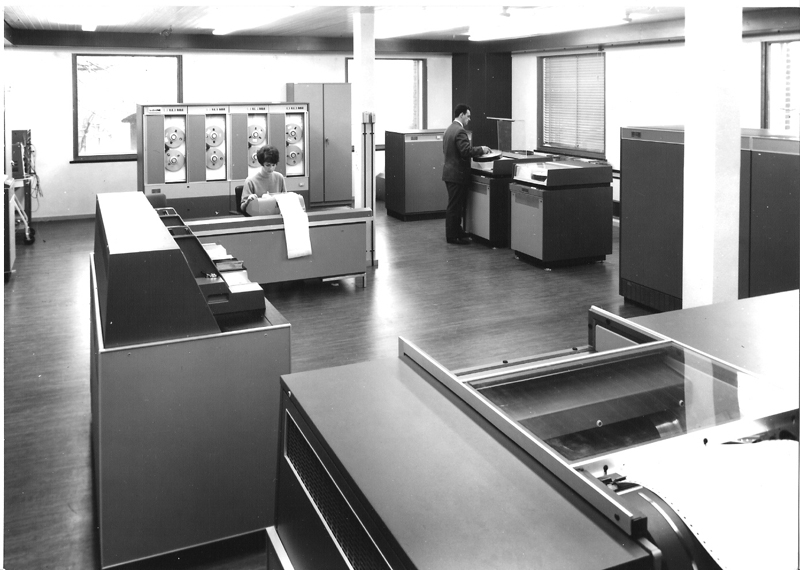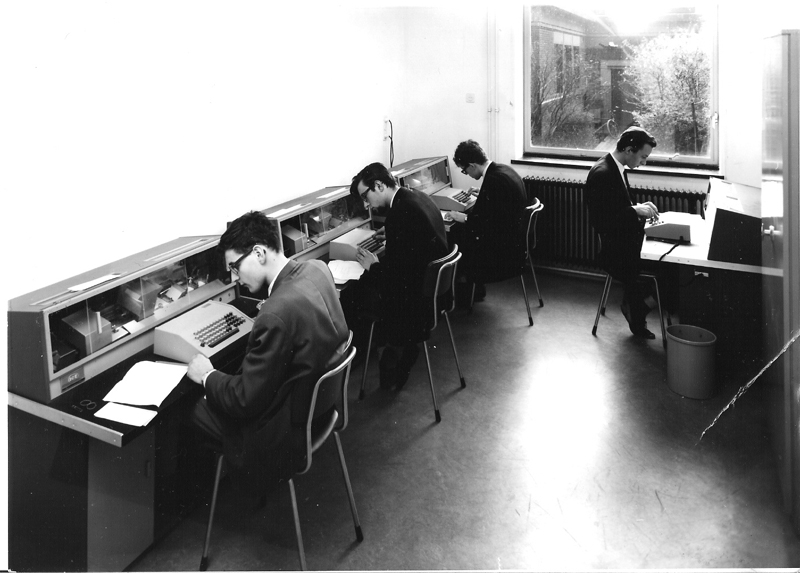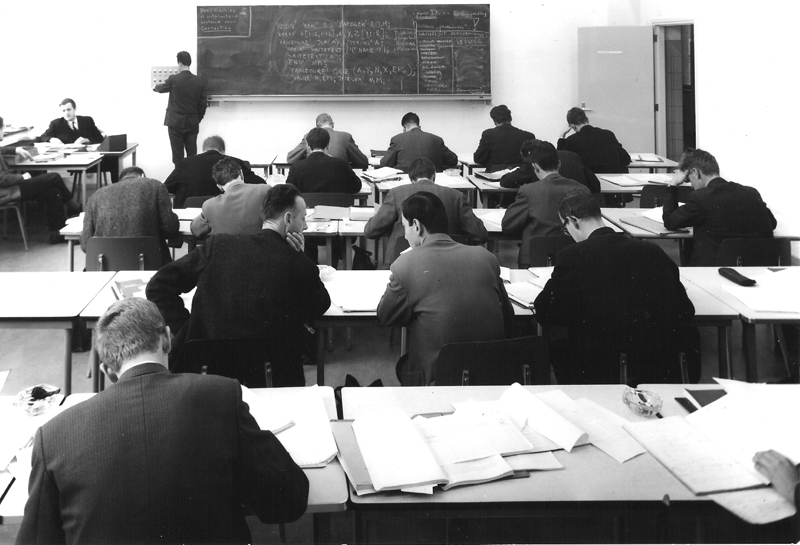ICL 1900 Series Machines in The Netherlands
The ICL 1905 at TH Delft
In the mid 1960's, there was as yet no formal teaching of a "Computer Science" curriculum at TH Delft, although some computer-related classes were given under the rubric of Numerical Analysis (Numerieke Wiskunde). The primary computer for this activity at that time was a Telefunken TR4 and some informal sharing of a Stantec Zebra (Zeer Eenvoudig Binair Reken Aparaat) owned by the Luchtkarteerings Instituut (Insitute for Aerial Mapping) also located in Delft close to the University.In 1965, negotiations were started with Ruys Handelsvereeniging (the agent for ICT, later ICL, in The Netherlands) for the lease or purchase of an ICL 1909 computer. The latter was a member of the 1900 series of computers which were in turn derived from a Canadian machine called the Ferranti-Packard 6000. Specifically The 1909 was a cost-reduced package for academic institutions - it had the slower CPU of the commercial-processing oriented 1904 but contained faster floating point capabilities to make it a "scientific" computer. (I'm not sure whether this floating-point speed improvement was a matter of emulation versus micro-code versus real hardware, but it was in that area.)
However, ICL also had a machine specifically designed for scientific use with a faster clock speed and even better floating-point capabilities called the 1905. However, not many academic institutions could afford such a beast - which is why ICL created the 1909 cost-reduced package for the academic world. The 1905 was at that time the second fastest scientific computer available in Europe, beaten only by the Ferranti Atlas which ironically was built by the same people who built the 1905. IBM's offering at the time was the already severely outdated 7090 while they were just in the throes of introducing the commercialy oriented 360 series, and the CDC 6600 was not yet permitted for export ouside of the USA given the cold war environment.
Professor Max Euwe from Univ. of Tilburg (a world-renowned chess-master) was called into the negotiations to act as an independent advisor, and somehow he persuaded the folks at ICL headquarters in London to provide a 1905 for the cost of a 1909. By putting this flagship machine at the most prestigious technical university in The Netherlands, it was hoped to forestall further inroads into the university market being made by Control Data Corporation. (There was a CDC 3150 at the Univ. of Tilburg, and Philips in Eindhoven had a CDC 3600. But that was the biggest machine that CDC was permitted to export at that time.
And that is how an ICL 1905 got to be delivered to TH Delft in approximately 1965. It remained the fastest computer in Holland only for a year or two until export permission was granted for the Zeeman Laboratory at the University of Amsterdam to acquire a crippled CDC 6400. This machine was restricted by agreement to running only the Chippewa Operating System and solely for use in research related to bubble chambers. It was only in the early 1970's that the University of Groningen got permission to acquire a CDC Cyber 74 with a full complement of software.(This machine was a re-engineered version and compatible successor to the CDC 6600, using integrated circuits instead of discrete components.)
In the back of the room we can see the 4 tape units, and to their right the operator is mounting a disk pack on one of the two disk drives. Originally when the machine arrived there were no disk drives, and the Algol compiler was loaded from overlays on tape. Later when a version of the Algol compiler was available which could pull its overlays from disk, the throughput of the machine when compiling student jobs was almost doubled by this addition, although it did not make much difference when running large production calculations. Further to the right and partially hidden behind the pillar we can just see the end of the CPU, and in the bottom right-hand corner we have the top of the high-speed printer.
In front of the tape units, the lady is sitting at the operator's console which consisted of a Teletype Model 33 that communicated with a very rudimentary operating system called "The Executive". Initially there was no facility for "job cards" to control the flow of work through the machine, this was all done by typing in manual commands at the teletype. Later a primitive sytem was cobbled together which permitted the teletype commands to be punched into cards which were then placed in front of the "job deck" which usually consisted of an Algol source program followed by data.
In front of the operator in the left of the picture we can see the card reader.
In the vary far rear corner on the left can be seen some maintenance equipment (oscilloscope, signal generator, etc.) but this space was later taken up by a Calcomp plotter (drum type) which was used for early research into rendering graphics by computer. One of the first PhD Theses at Delft to use this device concerned generating perspective drawings of physical objects and an Algol-based solution the "hidden line removal" problem.
Next to the computer romm was the "Pons Kamer" (Keypunch room). Students first wrote out their programs in long-hand on coding sheets which were then reviewed by teaching assistants or graduate students. After gaining approval, the students then typed their programs into punched cards and then submitted their jobs for processing. Results were generaly available on a 24-hour turn-around basis.
Next to the keypunch room was the lecture hall associated with the computer facility. Remember that these were not classes in Computer Science as we know it today. Rather they were part of the Numerical Analysis curriculum for engineers who it was felt should have at least some grounding in the use of computers, specifically the ability to write and execute a non-trivial Algol program in support of finding a solution.


